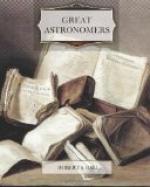The following circumstances have been authenticated by the signatures of Provosts, Proctors, Bursars, and other College dignitaries:—In 1793 the Board ordered two of the clocks at the observatory to be sent to Mr. Crosthwaite for repairs. Seven years later, in 1800, Mr. Crosthwaite was asked if the clocks were ready. This impatience was clearly unreasonable, for even in four more years, 1804, we find the two clocks were still in hand. Two years later, in 1806, the Board determined to take vigorous action by asking the Bursar to call upon Crosthwaite. This evidently produced some effect, for in the following year, 1807, the Professor had no doubt that the clocks would be speedily returned. After eight years more, in 1815, one of the clocks was still being repaired, and so it was in 1816, which is the last record we have of these interesting timepieces. Astronomers are, however, accustomed to deal with such stupendous periods in their calculations, that even the time taken to repair a clock seems but small in comparison.
The long tenure of the chair of Astronomy by Brinkley is divided into two nearly equal periods by the year in which the great circle was erected. Brinkley was eighteen years waiting for his telescope, and he had eighteen years more in which to use it. During the first of these periods Brinkley devoted himself to mathematical research; during the latter he became a celebrated astronomer. Brinkley’s mathematical labours procured for their author some reputation as a mathematician. They appear to be works of considerable mathematical elegance, but not indicating any great power of original thought. Perhaps it has been prejudicial to Brinkley’s fame in this direction, that he was immediately followed in his chair by so mighty a genius as William Rowan Hamilton.
After the great circle had been at last erected, Brinkley was able to begin his astronomical work in earnest. Nor was there much time to lose. He was already forty-five years old, a year older than was Herschel when he commenced his immortal career at Slough. Stimulated by the consciousness of having the command of an instrument of unique perfection, Brinkley loftily attempted the very highest class of astronomical research. He resolved to measure anew with his own eye and with his own hand the constants of aberration and of nutation. He also strove to solve that great problem of the universe, the discovery of the distance of a fixed star.
These were noble problems, and they were nobly attacked. But to appraise with justice this work of Brinkley, done seventy years ago, we must not apply to it the same criterion as we would think right to apply to similar work were it done now. We do not any longer use Brinkley’s constant of aberration, nor do we now think that Brinkley’s determinations of the star distances were reliable. But, nevertheless, his investigations exercised a marked influence on the progress of science; they stimulated the study of the principles on which exact measurements were to be conducted.




